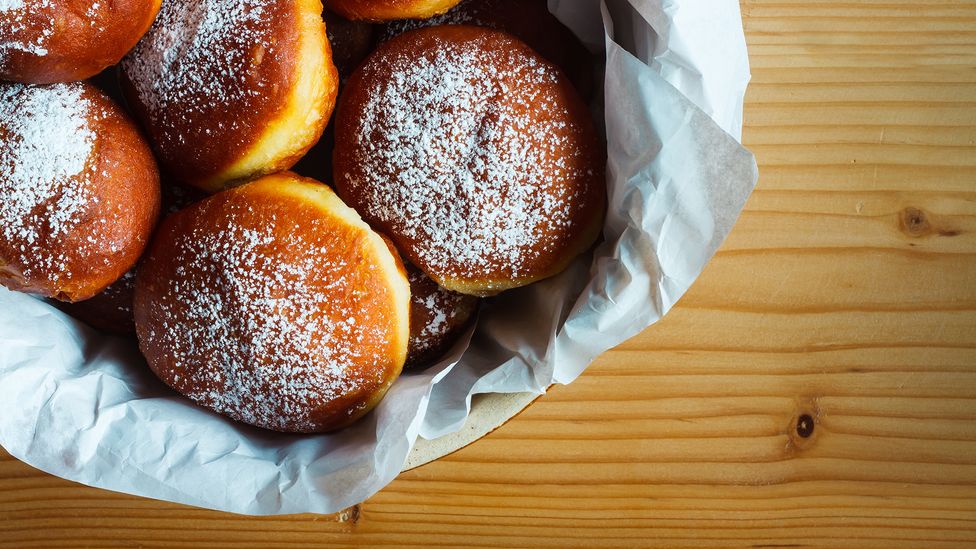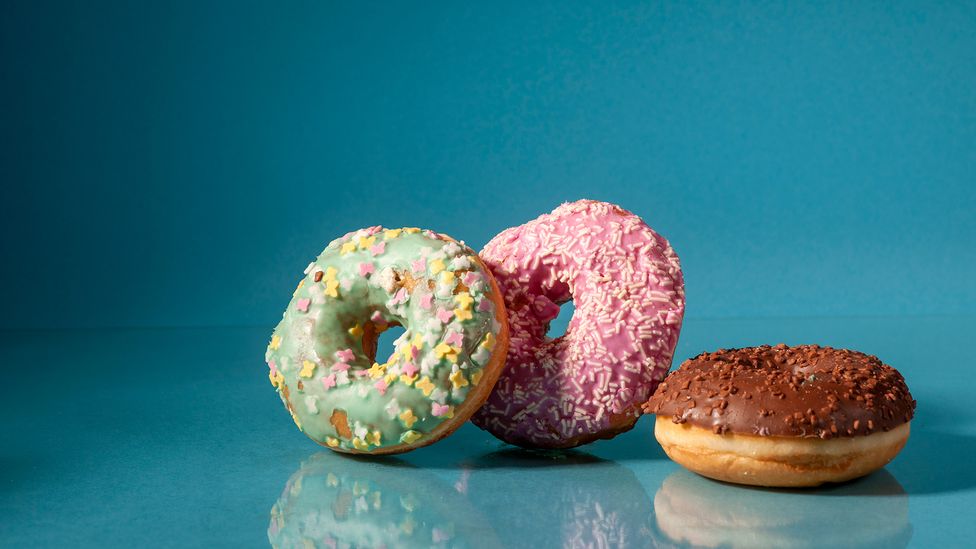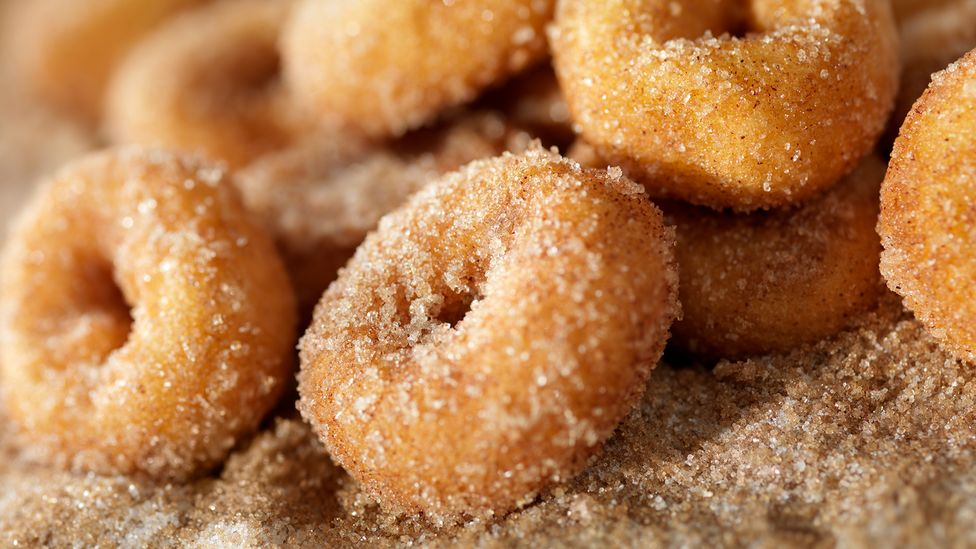Doughnuts travelled to the US with Dutch settlers and became a much-loved national snack – despite their invention as a hunger-busting austerity food.
T
There is a soft place in most hearts reserved for doughnuts: the pillowy texture, the crisp jacket of glazing, the sweetness so sweet it almost could put you off doughnuts, but never does, or at least not for long. In bakeries the warm yellow glow of tray upon tray of doughnuts has greeted many a morning customer and lightened many a load. I remember fondly the maple-frosting-capped pastries that graced the shop in my hometown, and chances are, you have an evocative doughnut memory of your own, a madeleine that's been deep-fat fried.
Fried dough is an old, old vice. It probably has been on the menu for as long as flour has been milled and large quantities of animal fat or oil have been on hand. But doughnuts as we usually imagine them are a relatively young food. The North American version known by that name in shops around the world seems to have its origins in the decades after the American Revolution, when a Dutch treat took on a new identity.
Reading histories of the doughnut, you might be surprised to find that the confection has long been tinged with nationalism. At the same time that the new nation of the United States was trying to find its footing in the world, its denizens were trying to figure out what was essential about it – about its literature, about its national character, about its food. This meant that writers and commentators looked back on the (rather short) history of the country with a kind of nostalgia mingled with bravado.
Before New York was New York, of course, it was New Amsterdam, and writers often reflected on the Dutch customs of earlier eras with treacly fondness. One of these customs was the making of fried dough balls, known as oliekoecken, or oil cakes. A recipe for these treats appears in a 17th-Century Dutch cookbook: they are leavened with yeast and studded with dried fruit.
You might also like:
- The clever science behind frozen ramen
- The man growing lettuce for space stations
- How China learned to love milk
One of the earliest mentions of doughnuts in American writing came from Washington Irving, the writer and diplomat, best known for The Legend of Sleepy Hollow and Rip Van Winkle. In his 1809 Knickerbocker's History of New York, he goes on at length about quaint Amero-Dutch folkways, describing the "primitive tea parties" of the not-so-distant past: "These fashionable parties were generally confined to the higher classes, or noblesse: that is to say, such as kept their own cows and drove their own wagons," he wrote with a mix of sentimentality and condescension. "It was always sure to boast an enormous dish of balls of sweetened dough, fried in hog's fat, and called doughnuts, or olykoeks – a delicious kind of cake, at present scarce known in this city, except in genuine Dutch families."

Though doughnuts have become ingrained in American cuisine, they were brought there by European settlers (Credit: Piotr Malcyk/Getty Images)
Identifying the doughnut as a down-home, folksy food made it more than just dessert – it gave it the colour of an authentic American treat. (The name, by the way, posits Jon Townsend of the YouTube channel 18th Century Cooking, could be derived from the already-well-established confection called ginger nuts, which are little round cookies about the size of walnuts. Doughnuts are little round balls of dough, and thus they are "nuts".)
The fantasies of homespun goodness surrounding doughnuts continued. More than 50 years after Irving wrote about them, doughnuts had achieved their modern circular shape – but the true how-and-why of this transformation have been lost to time, buried by a just-so-story involving a New England sailor and his mother. One version of this legend holds that Hanson Gregory's mother made doughnuts to take on his trips and he jammed it over a handle on the ship's steering wheel to eat during a storm, but there are nearly infinite variations. Perhaps one needs to look no farther than the material science of the doughnut to understand its perforation: A wad of thick, wet dough tossed into hot oil will still be raw in the middle after the outside is cooked. But if you insist on having a mega-sized pastry, a hole through the centre will help ensure it's evenly cooked.
The culture of New England whaling vessels also involved what are likely to have been slightly fishy doughnuts. With vast quantities of whale fat onboard after a capture and rendering vats on hand, frying was the logical thing to do, Michael Krondl reports in his book The Donut: History, Recipes, and Lore from Boston to Berlin. "Men all singing and bawling Doughnuts," wrote Mary Brewster, who was onboard a whaler in 1845 as a catch was hauled in. The next day, she wrote: "This afternoon the men are frying doughnuts… and seem to be enjoying themselves merrily."
Doughnuts' folksy cred may have reached its apex with the doughnut girls of World War One, Salvation Army volunteers who fried doughnuts for American troops. Hundreds of thousands of them were handed out near the trenches, and posters and tributes to these women's devotion in bringing a taste of home to soldiers abound. The Salvation Army's profile was likewise elevated. By the time the war ended, "their chosen totem, the donut [sic], was an ingrained symbol of home," writes John T Edge in his book Donuts: An American Passion.

The modern doughnut is seen as a dessert, but earlier varitieties were much more rustic - some even fried by sailors in whale oil (Credit: Christine von Diepenbroek/Getty Images)
But for at least one doughnut girl, the treat's pleasure was gone. Helen Purviance, who was reported to have fried a million doughnuts during the war, was interviewed by the New York Times on the occasion of a Salvation Army fundraiser afterwards, when she made doughnuts at the Savoy. "Miss Purviance said she did not relish the job of cooking doughnuts," the report read. "She said that she has come to associate doughnut frying with the 'horrors of the war'."
"There is no glory in war," she told the reporter.
Indeed, for all the joy a doughnut brings, fried dough is something you make when you don't have anything better around – on a whaling ship, for instance, or by a muddy trench. (Most famously, Native American frybread rose to prominence as a food of adversity; it was made by people being horrifically wrenched from their homes by US resettlement policies.)
The doughnut of the modern shop may be wrapped up in a narrative of American homespun delights. But fried dough is a comforter of souls, in distressed circumstances or otherwise, the world over. Look beyond the usual options and you'll find a doughnut in most every culture, each of them with their own stories, their own romances, their own devotees who will tell you just exactly what makes a good one.
--
Join one million Future fans by liking us on Facebook, or follow us on Twitter or Instagram.
If you liked this story, sign up for the weekly bbc.com features newsletter, called “The Essential List”. A handpicked selection of stories from BBC Future, Culture, Worklife, and Travel, delivered to your inbox every Friday.
